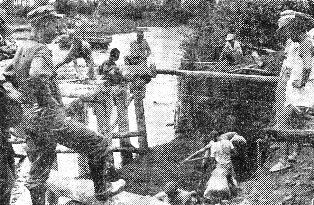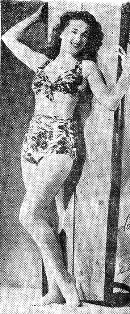

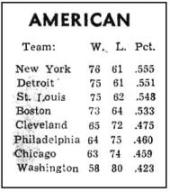
VOL. II NO. 42 REG NO. L5015 DELHI, THURSDAY JUNE 29, 1944
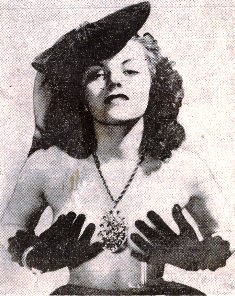 They are wearing black gloves in Philadelphia again this year. Ask showgirl Kathryn Case. She's wearing them.
They are wearing black gloves in Philadelphia again this year. Ask showgirl Kathryn Case. She's wearing them.
|
The grinning little ding how boys of Gen. Sun Li-jen's 38th Chinese Division and the British and Gurkha Chindits belonging to Maj. Gen. Walter Lentaigne raised a polyglot flag of victory over the Northern Burma town just in time for lunch on June 26.
It seemed that everybody had a hand in the fall of Mogaung. In addition to the 38th and the Chindits there was help from Kachin scouts, and Brig. Gen. Johnny Eagan's trigger-happy fliers bombed and shot up the town until little was left intact.
In the meantime, the bitter street fighting for Myitkyina continued. Chinese, American and Chindit forces ambushed, bombarded, bombed the Japs, used bazookas, flame throwers and all the small arms in the cruel business of wiping out pillbox after strongpoint.
MOGAUNG PRIZE
Mogaung is a prize almost as valuable as Mytikyina. It controls the headwaters of the Chindwin River, it is the railhead for the railway to both Mandalay and Myitkyina. It is at the junction of the all-weather road to Bhamo and Myitkyina - possible routes to the Burma Road.
Additionally it was the Japs' main supply base in Northern Burma. The men of Stilwell now have access to what remains of its warehouses, railroad facilities and ammunition dumps.
According to a Press Note, the combined forces attacked with such force that the Japanese were thrown into utter confusion. Although no further details are available at this time, it can be presumed that there was bitter hand-to-hand fighting and extensive use of mortars, grenades and machine guns to supplement artillery barrages and assaults from the air.
It must have been rough.
SOUTH OF KAMAING
South of Kamaing, meanwhile, a Chinese column in the two-mile stretch north of the Seton roadblock trapped a large japanese force and inflicted many casualties. In Myitkyina the Chinese have installed a bridgehead on the west bank of the Irrawaddy at the Waingmaw Ferry Road while the Chindits killed a large number of the enemy while making a surprise attack on Maingna, northeast of Myitkyina.
The capture of Mogaung is the climax of a long, bloody campaign for Sun's Chinese. It was the 38th Division that started over the Ledo Road on Oct. 26, 1943. Target - all they could get.
After a preliminary skirmish at Tagap, the Chinese invaded the Hukawng Valley about Nov. 1. The 38th was split into three columns heading for Yupbang Ga, Sharaw Ga and Taro. They got into trouble.
They got their noses skinned in three engagements and dug in to think the situation over. Nothing much happened until about Christmas time when they started to roll again and have been rolling without material setback ever since.
SUN'S MEN
It was one regiment of Sun's division that rescued the British at Yenanangyang in 1942 and walked out of Burma into India, through the jungles and through the monsoons, with all their equipment intact, in working order and with a minimum of casualties from disease or infection.
WITH UNCLE JOE'S BOYS IN NORTH BURMA
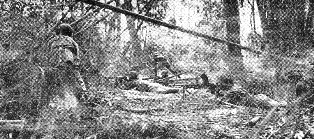 Men of the 22nd Chinese Division drive through the jungle in Northern Burma. Broken bamboo trees are results of
Jap shelling.
Men of the 22nd Chinese Division drive through the jungle in Northern Burma. Broken bamboo trees are results of
Jap shelling.
|
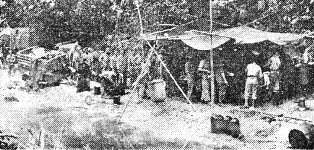 American tank crews line up for chow during a lull between fighting. They are hitting against the Nips with
Gen. Sherman tanks in the offensive to open the Ledo Road supply route to China.
American tank crews line up for chow during a lull between fighting. They are hitting against the Nips with
Gen. Sherman tanks in the offensive to open the Ledo Road supply route to China.
|
MORE RAIDS FOR JAPAN
NEW YORK - Gen. Henry H. Arnold, chief of the USAAF, promised Japan more B-29 raids when he spoke on the NBC Army Hour broadcast this week.
Said the General: "Two years ago we made our first attack on Japan. On June 15, we hit again. And I'm telling the Japs now - more attacks are on the way. The "day of wrath" for Japan is really beginning."
Pedro Talks, 'N Talks
By Sgt. SMITH DAWLESS
LEDO ROAD - Pedro is from Texas and easy-going. He merely shrugged when, during Saturday inspection, he was found short one spoon and two rounds of ammunition. His supply sergeant, an earnest fellow with a comptometer brain, demanded an accounting, "Where's that ammunition?"
PRIVATE LOUIE By Somerville
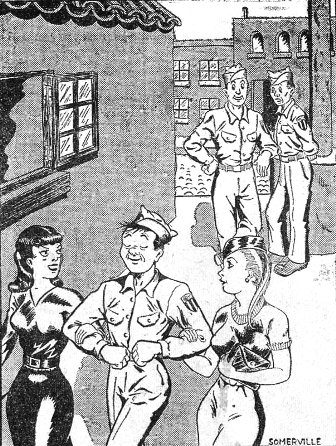
|
"Shot."
"Why'd you shoot 'em?"
"I didn't." Pedro looked slightly offended. An inquisitorial gleam flickered in the sergeant's eye. "I suppose some other guy did!"
"That's right." Pedro hummed Rancho Rio Grande and began to worry a splinter in his thumb. The sergeant parted company with his patience. "And just what d'your pals find to shoot around here?"
"Nothing"
"Nothning!" sputtered the sergeant. "You just said-"
"You see, it was not here, but up the Road." Pedro spoke as one addressing a small child. "We are riding along, and he stops the jeep and gets out."
THE DIALOGUE
"And you give him your gun."
"Oh, no. He has a gun. He picks up my clip by mistake."
"Yeah? What'd he shoot at?"
"A horse."
"A horse! Y'oughta know better than to shoot a horse."
Pedro made a gesture of protest. "But this one is hit by a truck."
DEAD HORSES ?
"Oh, Shootin' at dead horses!" The sergeant's nostrils dilated dangerously.
"No, he is not yet dead. So my friend puts him out of his misery."
Wham went the sergeant's fist against the bamboo desk. "Well he shoulda paid you back out of his own clip."
"Maybe," Pedro agreed, "Only his clip is empty."
The grinding of the sergeant's teeth was distinctly audible. "Well how in Hell am I supposed to make an expenditure slip on that?"
"I suggest," Pedro replied politely, "Expended Ammunition Rounds two. For the prevention of cruelty." But he did not say to whom.
Pedro is still short one spoon.
14TH AIR FORCE PILOTS POUND CHANGSHA AREA
HEADQUARTERS, 14TH AIR FORCE - Maj. Gen. Claire Chennault's 14th Air Force fighter and bomber pilots practically ignored the usual bad weather this week, as they continued to pound Japanese troops, shipping, installations and villages in the Changsha and Yellow River areas with good effect.
Most of the week's activity centered around the vicinity of Changsha, where B-25's sank several heavily-loaded enemy supply barges in the Siang River and bombed and strafed cavalry columns, killing 100 Jap troops and a number of horses.
|
STARTS WORKING IN CBI |
The Chinese-American Composite Wing sent out their P-40's to blast a village west of Sinagtan, where they ignited a large fuel dump and started huge fires while other fighters struck north of Hengyang and damaged nearly 40 enemy supply and troop barges, killing another 100 Japs. In stll another P-40 attack, and estimated 75 Nips were killed in the Hengyang area.
On June 25, the 14th AF increased the tempo of its attacks on Jap shipping. Near Hiangtan, fighters and bombers sank a 100-foot cargo vessel, killing a large number of Japs, and also damaged eight triple-decked troop carrying vessels.
Meanwhile, other B-25's, with P-40 escort, scored direct hits on the main Yellow River bridge at Chenghsi-En, causing severe damage. These planes also dealt a nasty blow to the villages of Sian-Siang and a smaller vilage to the southwest.
Liberators of the 14th also held up their end of the devastating assaults during the week. The most important raid by the B-24's came on the night of June 24 when enemy installations in the Hankow dock area were severely damaged.
Much-needed air support was given to the Chinese on the Salween Front by the Troop Carrier Squadrons of the 14th. More than 35 tins of food, ammunition and other supplies were air-dropped to the Chinese ground forces, whose ground supply routes have been considerably hampered by monsoon rains.
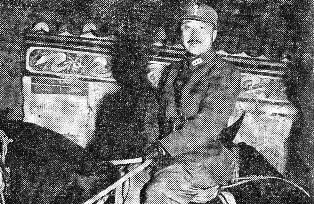 Marshall Wei Li Huang, Commander of Chinese Salween forces.
Marshall Wei Li Huang, Commander of Chinese Salween forces.
|
IN OFFENSIVE ON SALWEEN FRONT
SALWEEN FRONT - With the fall of Chiangtso this week, all enemy forces have been driven west and south of the Shweli River, on the northern sector of the Salween Front, Y-Force Headquarters has announced.
Chiangtso fell to the Chinese 20th Group Army, commanded by Gen. Huo Kuee-Chang, after they had attacked and taken Linchai pu, Tapa and Tahungmushu, all in the immediate vicinity of Chiangtso.
In the 45 days of fighting since the crossing of the Salween, the 20th Group Army has wrested from Japanese control about 4,000 square miles of the world's most difficult battle area, the Kaoli Kung mountain range. This was accompanied by continuous attacks on successive positions on which two years of enemy effort in organization and fortification had been expended.
HEAVY CASUALTIES
The advances were made over precipitous mountains in almost continual rain and sleet. Mountain trails, portions of which are impossible for animal support and which men must accomplish on all fours, presented almost impossible supply problems in these operations.
The Chinese suffered heavy casualties, more than 150 porters falling to death from slippery trails cut from sides of cliffs. The recent successes of the 20th Group Army makes easier advances down the Shweli Valley.
At Chiangtso large quantities of artillery and ammunition were taken and some small arms. The Chinese counted 150 dead Japs left in the town.
Threats of enemy encirclement moves on June 17 and 18, caused the evacuation of Chinese 11th Army troops from Lungling to positions east of the town. Reinforced Jap troops attacked these Chinese troops along the Burma Road, supported by five Jap tanks, one of which was destroyed.
14TH AIR SUPPORT
The Chinese troops all along the front, under the command of Marshall Wei Li Huang, and the American liaison troops, headed by Brig. Gen. Frank Dorn, have been greatly assisted by Maj. Gen. Claire L. Chennault's 14th Air Force.
Fourteenth Air Force fighters strafed a 400-animal pack train, causing heavy casualties, and also strafed and bombed 500 enemy troops caught on the road north of Lungling on June 21.
In severe fighting east of Lungling, the Chinese regained positions on high ground and reoccupied most of the village of Changlingkan, Chinese attacks continued on Jap forces still holding a portion of Hsiangta.
Elements of the 20th Army Group, on the night of June 19, attacked enemy fortified positions at Watien and Kuntungkai, captured Kuntungkai that night and Watien the following morning. The 20th Army Group is now consolidating positions and bringing up reserves, preparatory to an advance on Tengchung. At last reports the Chinese were five miles from this key town.
The japanese, who were pursued in the precipate enemy retreat from Chiaotou, are being eliminated in scattered isolated positions along the line of flight. Chiaotou was captured on June 17 after continuous assaults and heavy fighting.
EAC GROUND SUPPORT BEST EVER ANYWHERE
The monsoon has slowed up the air war in C.B.I.
It can't be helped, flying and monsoons being what they are. Whether the slow-up will be to a trot or a walk remains to be seen. Maj. Gen. George E. Stratemeyer, boss of the Eastern Air Command, thinks the pace will be trot or better. He should know.
The end of the mud months presumably will bring a step-up in air activity, an offensive mounted with new aircraft, new techniques. Let's let those who know tell us about it when the time comes.
But we do know something of what the Army Air Forces have done during the past few months.
They have made life very trying for the Japanese. They haven given ground forces what General "Strat" has called "the best support ever given any Army anywhere." And that isn't bad.
Air support doesn't mean just fighter cover. It means fighters, and mediums, and heavies, and troop carriers, and gliders. And it means the ground boys who keep the kites ticking.
This is no time, place or space for a solemn resume of the full doings of the Air Forces, up to the rains. But there were some very good days and nights. And a few bad ones.
GOOD ONE
Here's one of the good ones. Good for Brig. Gen. Bob Old and his Troop Carrier Command.
A little knot of 50 men paled the edge of what was nothing but a buffed-down cow pasture up in northeast India. It was darker than the inside of a wolf and just as hot. Flickering lightning showed thunderheads heaped on the hills. It also showed a dozen ambulances lined against the edge of the field.
It was about 0100. Suddenly, there was a low drone from the east. Cigarette butts went underfoot. A plane passed overhead. An Aldis lamp winked, was answered. The plane circled, eased down. Four flares marked the corner of the field. There was no flare path. A C-47 topped the trees at the field edge, felt for the ground, found it. It was followed by another and another. Several more.
THE MEDICS
The medics gently unloaded men who had been badly hurt during the Cochran raid behind Jap lines. The cigarettes glowed again. The planes taxied to the far end of the field, went off. Home? Hell, no. Back for another load. Spectacular? Routine.
There was another good day, this one for a group of medium bombers, working with Air Vice Marshal Sir John Baldwin's 3rd Tactical Air Force.
The target was a tricky one. Here was one town, held by British troops. Less than 1,000 yards away was a heavy concentration of Japs. The Japs were to be removed. The bomb line was a road, mid-between the two forces
IMPHAL BOUND
The B-25's barreled up toward Imphal. The formation was so tight that from the waist of one ship you could tell the color of the gunner's hair in the aircraft on your wing. Lip reading was practiced at 10,000 feet.
Ten minutes off the target, the clouds broke. The squadron leader passed over the target, deliberately circled to make sure doubly sure. There must be no slip, no misidentification.
There wasn't. From the leading element, 24 bombs were away. Twent-three strung down the main street of the target area. One missed. By about 50 feet. The Japs were removed.
LONGEST RUN
Until the B-29's were turned loose, the kids in one group of heavy bombers based in India were flying the longest missions, anywhere, India to Rangoon, to Bangkok and beyond.
One day, up over northern Burma, the weather closed in and they couldn't see very much. The target was small. From the air pictures it looked the size of a G.I. six-holer. The bombardier from Brooklyn cursed and mumbled. They struck a cloud rift, went in for a bomb run. The bombardier missed the target, spread his bombs in an acre of jungle and blew up a gasoline dump which the Japs thought they had hidden.
There was a fighter squadron, commanded by a burly Kansas boy, Maj. Verl Luehring. They flew the P-38's and devised strange and wonderful ways to kill Japs.
THE QUOTA
They decided back in March to set a quota. Their motto was "100 Jap Planes By The Monsoon." They started out. They destroyed Japanese in the air, at 10,000 feet. The flew into Jap revetments at six feet. One day they went out hunting and bagged 10 Nips in three hours, air and ground.
And when the monsoon set in, they had more than 125 Nips on the hip.
There is no need repeated what Colonel Cochran's Commandos did in the Jap's back yard. Except maybe the story about the glider pilot who fish-tailed into that chaotic landing strip about dawn, overshot, smashed the glider to junk, climbed out with a broken nose, dusted his hands and said: "Well, that's that."
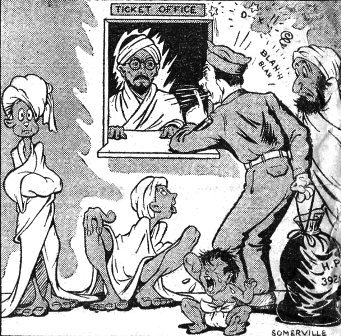
|
SIMPLE IN OMAR'S STYLE
The railway system of India is one of the major reasons why experts predict a vast expansion of air travel after the current unpleasantness is over. Travel orders come sooner or later to G.I.'s in India, however, as they must to all men. That product of some legal eagle, that pregnant phrase, " via air or rail transportation," leaps to haunt the prospective jaunter.
Indian railway track comes in three yardages, broad (Ha!), narrow, and narrower gauges, plus some uncatalogued widths which crop up unexpectedly to add rustic charm to the country. Trains are referred to as the Lahore-Up or the Allahabad-Down, creating a sense of vertical motion which often becomes violent in certain sections of roadbed.
Tickets are sold, or "booked," for first, second, third and interclass, the last implying, quite literally, that you are treveling in no class at all. Shrewd Stateside characters of big-city upbringing sometimes try to skip a grade, however, and ride the plush with a down-priced ducat. If caught, however, they run smack into rule 52, which states in part:
"Provided that where the passenger has immediately after incurring the charge and before being detected by a railway servant notifies to the railway servant on duty with the train the fact of the charge having been incurred the excess charge shall be one-sixth of the excess charge otherwise payable calculated to the nearest anna, or two annas, whichever is greater." You can readily see this is rugged, if not confusing.
Toll-worn troops enroute to any of the various rest camps in India for an invigorating two weeks of bracing climate, rich food and pleasant recreation bounce merrily along on the third class boards. These "special" troop trains rocket along at speeds up to 15 and 17 miles an hour, but often must be shunted of on a siding to rest and give the right-of-way to some slow freight.
Life in third class carriages is tastefully simple and plain. A barren bench, a water tap, a hole in the floor, and thou.
The "convenience compartment" is situated fore rather than aft, so that on those rare occasions when the train is in motion, riders have its lovely aura blown back in their faces.
The well=padded aristocracy of the first class coaches wire ahead to the various Fred Harveys of India for meals at the stations, but troops gleefully gobble their iron rations and decant garam panee from the grinning engineer wallah's locomotive to brew poisonous coffee with atexture like crude oil.
Indian railway stations have more compartments than a hineycomb, what with the first, second, third and inter-class waiting rooms, refreshment rooms and "retiring rooms" plus separate short order joints for Hindus and Mohammedans. By the time all the various categories have been satisfied, even a whistle stop offers a pretty sizable establishment, the floor space of which is invariably used in lieu of boudoir at night by the local populace.
When the Kanchenjunga Choo-Choo, one of India's crack fliers, staggers into a station, passengers in the already sardine-packed compartments unsportingly throw the door bolts which were originally intended for the protection of "ladies, traveling alone."
This no whit discourages the howling mob of ticket-holders outside who proceed to clamber through the windows, aided by husky shoves from outside. The "ins" just as unabashedly shove them back.
Ambitiously, however, the railways also endeavour to haul pet dogs, at an interesting per canine rate of 5 annas the first 300 miles and 4 annas for each additional 50 miles. Smuggling is severely dealt with: "If the dog is detected unbooked, ordinary charges, i.e., double the dog-box rates, will be recovered." Between dishonest passengers and unbooked dogs, Indian trainmen spend considerable time "detecting."
No one "rides the rods" on Indian railroads, which speaks pretty highly for the intelligence of the Hindustan hobos, who know a good thing to leave alone when they see it. These foreshortened goods wagons spend most of their time being booted around switching yards.
War-time theme of India's railway system is, "Don't ride the trains if you don't absolutely have to."
We concur.
Nip Forces Hit By Air Assault
During the past week the activities of Maj. Gen. George E. Stratemeyer's Eastern Air Command were concentrated principally upon furnishing air support to ground troops in the Myitkyina-Mogaung and Kohima-Imphal areas.
In this period 10th U.S. Air Force P-40's, P-51's and A-36's carried out repeated and successful bombing and strafing attacks on selected targets, including pillboxes, supply dumps, barracks areas, bridges, dugouts and revetments in the vicinity of Myitkyina and Mogaung. On June 19, P-51's and A-w36's bombed a troop train near Pinban, destroying the locomotive and one-third of the cars.
RAF fighters and fighter-bombers of the Third Tactical Air Force furnished close support to ground forces in the advance which cleared the Imphal-Kohima Road. In the early part of the week these aircraft carried out numerous successful attacks against Kharasom. Enemy concentrations in the vicinity of Ukruhl, Bishenpur and Sokpao were also heavily bombed and strafed.
On June 20, long-range RAF fighters of the Tactical Air Force breached the oil pipeline running between Prome and Okkan in three places, causing large fires. A locomotive was also hit on this mission. On the 24th, U.S. P-38's scored a direct hit with rocket projectiles on a 250-foot cargo vessel on the river at Mawlaik-kin.
JAPANESE CAPTURE TWO CHINESE TOWNS
CHUNGKING - Japanese troops captured Yuhsein and Hengshan this week as their offensive continued to sweep through the Hunan Province in Southeast China, Allied Headquarters has announced.
Capture of these two towns puts the Japs one step nearer the "rice bowl" communications center of Hengyang. A fierce battle is now in progress on the outskirts of Hengyang itself.
SCENES FROM CHINESE - U.S. OFFENSIVE TO OPEN LEDO ROAD
Wherever the Jap can be found he is being pounded by the forces of the United Nations. From the jungles of Bougainville to the jungles of Burma, the Nip is on the run.
Below we show you scenes from the war being fought on the China-Burma front against the Jap. Scenes of battle, injury, training and humor as Yanks and Chinese combine against their common foe.
Scene one is Chinese reinforcements coming in at the Myitkyina Air Field to aid in the drive on the Nip town garrison.
| |||||||||||||||||||||||||||
Scene two shows a spot of the Salween front where China's 20th and 22nd Group Armies are attempting to smash through enemy defenses and effect a junction with Lt. Gen. Joseph W. Stilwell's force to open the Ledo Road.
The second scene, depicting the Salween front, shows an area where all the ground fighting is done by the Chinese, with an American liaison group under Brig. Gen. Frank Dorn, working with them in their drive to link up with Stilwell's forces.
Scenes three and four show how medical units are operating on the Burma front. These two pictures show some of the treatment of a Chinese officer who was wounded at Mytikyina while fighting with the Chinese-American troops under Stilwell.
The story is worth telling. The wounded Chinese warrior is Lt. Jang Foo Chwan. He suffered wounds in both legs and one arm.
Rushed by a hospital plane from the front, he was administered $2,000 worth of penicillin in a 24-hour battle by medica against the deadly gas gangrene. Then, working in the surgery tent, ankle-deep in mud, and with the monsoon rains beating furiously on the canvas, the soldier's right leg was amputated by Lt. Col. C. J. Berne.
Following the operation, Capt. Reuben D. Chier, assistant surgeon, administered blood plasma, a gift of the Blood Bank of Los Angeles.
From the hospital scenes we take you back to Myitkyina where a wrecked Japanese bomber is shown nosed into a crater in the swampland near the airport. Yank anti-aircraft gunners were credited with alert defense work in Nip bombing attacks on the Allied forces there.
Next, we have a Chinese soldier, Sgt. Chen Lip Teh of a mortar company, firing a 82-mm Chinese mortar without a base plate. When the war first started, the Nips placed great emphasis on mortars, but now they are getting some of their own medicine.
Finally, we give one of the occasional smiles in war. A G.I. takes lessons in how to follow the etiquette book in downing his vitamins - with chopsticks.
These pictures show the close collaboration of the Chinese and Americans in their mutual push against the aggressors of Tokyo. This is true not only on the battlefield, but also when the fight is over and injured of both armies need attention.
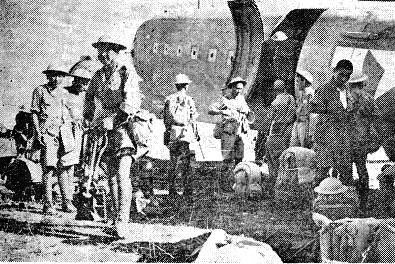 Fresh Chinese troops land at Myitkyina Airport, which was siezed in a surprise attack by American and Chinese forces.
Fresh Chinese troops land at Myitkyina Airport, which was siezed in a surprise attack by American and Chinese forces.
|
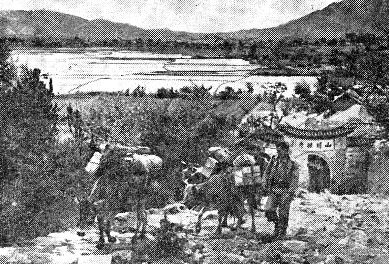 This gives you an idea of the Salween terrain. A G.I. uses a bullock for a pack mule up a hill.
This gives you an idea of the Salween terrain. A G.I. uses a bullock for a pack mule up a hill.
|
 ANC Lt. Pauline Hendershot administers blood plasma to Lt. Jang Foo Chwan. Cpl. L. M. Oswald, left, and Pvt. John
Marzano are stretcher bearers.
ANC Lt. Pauline Hendershot administers blood plasma to Lt. Jang Foo Chwan. Cpl. L. M. Oswald, left, and Pvt. John
Marzano are stretcher bearers.
|
 Lt. Col. C. J. Berne, at left, completes amputation. Left to right, ANC Lt. Mildred Lindberg, Capt. Reuben D. Chier,
ANC Lt. Hendershot, Sgt. Charles Stacy.
Lt. Col. C. J. Berne, at left, completes amputation. Left to right, ANC Lt. Mildred Lindberg, Capt. Reuben D. Chier,
ANC Lt. Hendershot, Sgt. Charles Stacy.
|
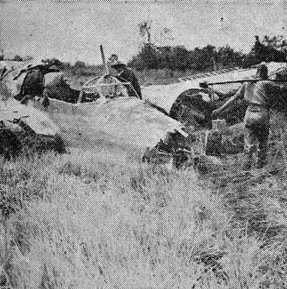 A bomb crater near Myitkyina Airdrome is the grave for this Nip bomber, which nosed into the hole near the swampland.
A bomb crater near Myitkyina Airdrome is the grave for this Nip bomber, which nosed into the hole near the swampland.
|
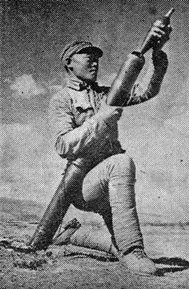 Sgt. Chen Lip Teh shows how he fires his mortar without the use of a base plate.
Sgt. Chen Lip Teh shows how he fires his mortar without the use of a base plate.
|
 This G.I. serving as a code clerk with Chinese attached to Stilwell's army, learns how to eat with chopsticks.
This G.I. serving as a code clerk with Chinese attached to Stilwell's army, learns how to eat with chopsticks.
|
LEDO ROAD ENGINEERS BATTLE MONSOON MUD
LEDO ROAD - Today two wars are being fought in Northern Burma.
Foremost in attention is the hard-hitting offensive against the Japs by the Chinese and American troops under Lt. Gen. Joseph W. Stilwell.
But vitally necessary to this effort, is a vast defensive operation behind the lines by Brig. Gen. Lewis A. Pick's Engineers against another vicious enemy - the dreaded monsoon.
SUPPLIES TO STILWELL
Working in knee-deep mud, oppresive humidity and constantly harassed by leeches and malarial mosquitos, the men battle to keep open the famous Ledo Road, for over this Army highway flow the precious supplies, ammunition and equipment needed by Stilwell to whip the Japs.
Many places where this supply route winds today, white men never trod before. Over choppy, thick, jungled mountains and through steaming, musty swamps this famous highway carries communications and transportation forward.
Last year's monsoon, with the project barely started, proved that an intelligent, definite program of maintenance was necessary. As a result, Pick and his staff, have formulated a plan to battle the elements this year.
|
WHEN IT RAINS
Almost insurmountable obstacles are encountered at every turn. Accurate figures on rainfall are not available, but it has been conservatively estimated that over 200 inches of rain drops in the four months from May 15 to September 15. In the United States, 45 inches of rain a year is considered excessive.
The saturated earth brings towering, heavy trees tumbling across the road. During a rainy spell, it is not unusual for the toiling Engineers to cut and drag a dozen from the highway in a 30-mile stretch.
For time-saving efficiency the road is divided into convenient maintenance sections. Amiable, hard working Lt. Col. Warren George, Of St. Louis, Mo., who has charge of a particularly mountainous portion, stated that action is immediate when trouble occurs and 24 hour schedules are maintained.
BRIDGES POUNDED
Bridges are constantly pounded by logs and trees, brought down stream by torrential rains.
At 3 a.m. one morning, a 150-ft. span was reported severely damaged by flash flood. By 8 a.m. a plan was prepared, materials and men dispatched to alleviate the trouble.
The old structure was reinforced to carry traffic late the same day, and on the ninth day, a complete new bridge was finished, adjacent to the spot.
IMMEDIATE PLAN
Each bridge and every danger spot is studied by the vigilant Engineers, so that if trouble occurs, an immediate plan is available to overcome the condition.
Earth slides are a blessing in disguise, George pointed out. Any condition that develops, requiring emergency treatment is the sign of a weak spot. Therefore, the road is daily being improved as maintenance continues.
The Ledo Road is still no tourist's boulevard. Steep, alpine grades that would terrify road bulders in America are to be found at every turn.
CRACK FIGHTER PILOTS PROTECT B-29 AIRBASE
CHINA - The sprawling, giant bomber bases, from which the B-29s of the 20th Bomber Command are operating against Japan, are protected by the newly-activated 312th Fighter Wing of the 14th Air Force, stationed at inner perimeter bases as well as outer ring Chinese bases.
The 312th is equipped with single-engined fighters of the lastest design.
Like the 20th Bomber Command, the fighter wing is built around a nucleus of squadrons, veterans of the European air war and who have been in action against the Italian Air Force and the Luftwaffe since the first landing in North Africa. Their last assignment before coming to China was to provide protective air cover for the landings at Anzio and Nettuno beachheads.
ICE CREAM SERVICE FOR G.I.'S IN WILDERNESS
LEDO ROAD - As the jeep careened to a sliding stop, the wild-eyed G.I. with the square, galvanized pail swinging from his fist was on the ground and running. He skidded and shuffled on the slick muddy road, then suddenly his legs whipped the air and he was inert and sprawling in the mire.
With anxious face another soldier dashed out of a nearby tent and bent over his stretched out form, the picture of concern, to query - "Well, did you get the ice cream?"
In such high regard are held the offerings of the Jungle Joy Ice Cream Company, run by a couple of fs the road.
Working with only a small counter freezer, operated by a rehabilitated generator, these two Good-Humor wallahs put the freeze on numerous gallons of ice cream mash daily, sometimes operating a swingshift when the sales curve zooms upward.
Every three weeks sweets-starved jungle jumpers from units within a 15-mile radius draw ice cream for their unit messes, flocking to the factory like yokels 'round a medicine show. They wheel up in jeeps, weapons carriers, and "6 bys," grab the loot, then take off as to a four-alarm fire in order to arrive home before melting sets in.
Presumably, the stuff is paid for, appropriately enough, from the respective unit slush funds. Gregory and Edens get quite a lift out of the fine fever with which the lads go for their product, first of the luxuries of soft civilization to hit the old Assam-Burma turnpike. More goodies are probably in store, however, for the road has some splendid hot dog stand frontages, and there are unlimited opportunities in the beverage line for anyone who can get a priority for the necessary copper pipes.
BISSELL PRAISES CBI OPERATIONS
Maj. Gen. Clayton Bissell, former 10th AF head in the CBI, has written the Roundup the following:
"Copies of the CBI Roundup being sent to me are arriving regularly. They are much enjoyed and help to maintain the personal interest I will always have in all activities of the CBI Theater.
"Congratulations to all on the splendid results being accomplished by both the Ground and Air Forces and best wishes to all."
Bissell is now head of Army Intelligence.
AWAY TOO LONG? CAN'T HAPPEN HERE
SUPER AIR BASE, ASIA - At this secret American airbase in remote western China, Lt. Pat A. Chance, of Los Angeles, Calif., was one of 26 American Engineers who supervised the construction of the huge B-29 bomber bases.
Discussing his experience, Chance said, "I've built roads and airports throughout the Midwest for seven years before entering the Army. But when the war is over, I know what'll happen. When I apply for a civilian job, they'll hand me a form to fill out. There'll be a dotted line: 'Past experience and size of job handled.' I'll answer that one with: 'Built an airbase with 45,000 coolies and little else.'
"I can see 'em now, shaking their heads sadly and whispering, 'Poor old Pat. He's been away too long.'"
|
Railway Boys' Personal Pick
Included In New Kit
Well, wrap me up a dozen! This lovely layout you've been sagging your jaw at for some minutes belongs to Margie Stewart, RKO Hollywood model, and is included in the new Special Services X kit now being readied for issue to overseas unit. Something for the boys.
Margie's face (better look again) on a security poster put out by a joker with no imagination in Shangri-La mousetrapped the hearts of some military railway transport boys now in CBI-land. They mailed her a few goofey wolfnotes and got this shot of the gal, face and gorgeous all.
Capt. Francis G. Clisham, chief trackwalker of the R.R. outfit, who is cunningly holding the Roundup editor's right eye as security for return of the picture, advises his boys haved voted Margie "The Girl We Would Like Most To Share Our Mosquito Repellent, Fighter Brand, Beer Ratio, and Basha With." What about the caboose?
Buffin Named Photo Unit CO
New Commanding Officer of CBI's oldest Photo Reconn squadron is Capt. John E. Buffin, of Carlisle, Pa., succeeding Maj. Henry E. Miller, of Fort Wayne, Ind., who has returned to the States.
For his work with the Photo Reconn unit, Buffin has been awarded the Air Medal and the DFC, the latter for being the first 10th Air Force pilot to photograph Bangkok, a 5,000 mile mission, requiring three days and five landings to complete.
CBI PATCH AGAIN EXPLAINED
In response to various queries from newcomers, we herewith again explain the CBI shoulder patch.

|
This eye-arresting bauble came from the fertile brain of Brig. Gen. Frank (Pinkie) Dorn back in June of 1942. At that time Pinkie was aide to Lt. Gen. Joseph W. Stilwell and is now in command of the American Liaison Group with the Chinese on the Salween.
The red-white-and-blue motif is naturally Uncle Sugar. The gadget in the upper left hand corner of the shield is the Kuomintang Sun. (The Kuomintang is the ruling political party of China - hence the sun is the national emblem).
The star is the Star of India. A peacock for Burma might have been added plus the white elephant of Indo-China, but, like newspapers, Pinkie was short of space.
BRITISH FORCES CLEAR IMPHAL-KOHIMA ROAD
KANDY - Clearance of the Imphal-Kohima Road by forces of the british 14th Army under the command of Lt. Gen. William Joseph Slim has been announced by SEAC.
Coming at the end of more than 12 weeks of the hardest sort of jungle fighting, the repulse of the Japanese attackers represents a triumph of long-range strategy, reinforced by superior tactics.
Jap forces are reported east and west of the road in scattered numbers and it is believed that survivors of the recent fighting are badly emaciated. The Japanese are rapidly being liquidated.
The opening of the Imphal-Kohima Highway was accomplished by British troopsof the 14th Army moving south to Imphal and british and Indian units fighting to the north.
The entire campaign was supported by aircraft of the Strategic and tactical Air Forces, under the command of Maj. Gen. George E. Stratemeyer.
 A U.S. Army observer with the 14th British Army on the Imphal front. At left: Lt. Col. J. F. B. Lyons studies a
map with Maj. Gen. H. R. Briggs of the 14th.
A U.S. Army observer with the 14th British Army on the Imphal front. At left: Lt. Col. J. F. B. Lyons studies a
map with Maj. Gen. H. R. Briggs of the 14th.
|
JAP DEMOLITIONS
Despite Jap demolition efforts, the road is reported to be serviceable.
Brunt of the fighting has been borne by the 17th Indian Division and the 5th Indian Division which was transported to the Imphal front by air from the Arakan.
The fall of Imphal was announced several times by the Japanese, who, during early April, had good reason to anticipate a capitulation which never materialized. During a period of six weeks, Imphal was accessible to the Allies only by air.
Aircraft of the Troop Carrier Command made hundreds of two-way trips in and out to supply the besieged city.
IN APRIL
In mid-April, Kohima was under rigorous attack and four Japanese divisions were thrusting in parallel columns toward and across the strategically important road.
At the end of April, British, Indian and Gurkha troops, supported by tanks, succeeded in effecting the relief of Kohoma and within a week, had driven through to the Dimapur railhead.
The latter action probably thwarted the primary aim of the entire Japanese campaign, for had the railhead fallen into their hands, the Assam Railway's line of supply to General Stilwell's troops in northern Burma would have been sliced.
The Japanese attempts to invest the Imphal-Kohima Road have been very costly to the invaders. The Jap division, opposed by the 17th Indian Division, has been thoroughly decimated, while the Jap 31st and 15th Divisions, according to captured prisoners, are greatly weakened by casualties, hunger and disease.
The Japs are estimated to have begun the campaign with about 62,000 effectives, representing four full divisions. It is believed that more than one quarter of this force has been killed and less than one quarter now can be regarded as in able fighting condition.

|
OVERSIZED SHOES EN ROUTE TO BAREFOOT YANK
T/4 Paul W. Crow, according to his letter published in the Roundup on June 15, has been having one helluva time getting a pair of shoes. He wears size 14½-A which he feels is none too big to cover the puppies of a guy who stretches six feet five inches into the ozone and hammers the Fairbanks down at 225 pounds.
He suggested:"How about a Shoes for Crow Camapign?"
The Roundup has run a few campaigns in its day. We got Pfc. Marvin Collins a set of false teeth, so why not shoes for Crow?
Comes now the intelligence that Per Diem Hill's blanket-counters, after a theater-wide search, have discovered two pairs of these gargantuan brogans and have forwarded same to footsore T/4 Crow up in China. Additionally, Maj. Gen. W. E. R. (Billy) Covell, Commanding General, SOS, sent Crow the following letter:
"Dear Crow:
"Your sorry plight which has been brought on by a lack of shoes sufficiently large to cover your over-sized feet, has been called to my attention through your letter to the Editor of CBI Roundup.
"A careful check has been made of stock records all over the theater and we have finally discovered two pairs of 14½-A shoes in one of our warehouses. Finding these shoes was no easy job, for they had been stored away with other objects of similar size, namely enhineer bridge pontoons.
"I hope you will accept these shoes as a present from the Quartermaster and myself and further hope that their arrival will spare you from the many details which you dreaded being subjected to because of your shoeless condition.
"Our motto in the SOS is 'Find It, Furnish It, Fix It.' We have found your shoes. When the arrive at your station, which should be soon, we will have furnished them and after you wear them out give them back to us and we will fix them.
"Sincerely, W. E. R. Covell."
(Anybody else need anything? - Ed.)
CBI Theater For Relatives
LEDO ROAD - Things kept right on rolling in the "Well-isn't-it-a-small-you-know-what" department in CBI last week, with one reported addition each in the Father-meets-son and Brother-meets-brother branches.
Lt. Howard E. Wrench, personnel and supply officer of an Engineer Depot Company in Assam, ceased receiving letters from son T/5 Howard T. Wrench, whose Aviation Engineer outfit was in North Africa. And where did Wrench Jr. turn up next? Yep, Assam.
More persistent was the pursuit by Pvt. Lewis Goldman, also of an Engineer Depot Company, of brother Milton, whose parting words when he left for the Army in October 1942 were, "Kid, take care of the farm, and stay out of the Army." But Lewis was in service a year later, and a letter from Milt now advised, "I am in India with the Infantry, for gosh sakes stay out of this hole."
June 1944 finds Milt, a battle fatigued member of Merrill's Burma Raiders in an Assam hospital, and who is with him? Right, brother Lewis. With a deep sigh, the former makes a final attempt, "Well, anyhow kid, stay out of Burma."
Anybody can write the rest of this story.
Dead Eye' Egg-Layer
EAC HEADQUARTERS - "A bombardier's bombardier." That's the tribute given Capt. William L. Deck by his fellow fliers in respect for his precision bombing of Jap installations in Burma during the past year and a half.
Deck, 24-year-old Group Bombardier of the Strategic Air Forces, EAC, is a veteran of 550 combat hours, every one of which he has made painful for the enemy.
As an example of Deck's accuracy in precision bombing, his friends tell of his "three for three" attack, when he sank three Jap freighters in the mouth of the Rangoon River with three direct hits.
Deck however, is proudest of one of his raids during last year's monsoon season. On this mission, he dropped his "eggs" through a lone hole in the clouds to destroy the Chauk oil installations and a pumping station, north of Yenanyaung, a target only 100 feet square.
The captain's debut in CBI was one to remember. On his first bombing run, over heavily-defended Rangoon, his Liberator was attacked and "shot to hell" by seven Jap Zeros. One gunner was killed, another wounded, and Deck was also injured. The plane lumbered back to its base with 176 holes in the fuselage.
Overseas since December 1942, Deck now carries the Air Medal with two Oak Leaf Clusters, the DFC with Oak Leaf Cluster and the Purple Heart. If he is ever sent home, he says he'd like to become a dive-bomber pilot. "After all this high altitude stuff," he explains, "I'd Kinda like to see some of the targets."
NEW THEATER NAMED FOR G.I.
LEDO ROAD - On March 20, 1944, Pfc. Eugene A. Metz, member of an advance Engineering party on the Ledo Road, was killed by a Jap land mine.
This week, at this remote sub-depot, a new outdoor theater has been named in Metz' honor.
| Dow Jones STOCK AVERAGES |
|||
|---|---|---|---|
| June 24 | June 17 | Last Year | |
| 30 Industrials | 147.48 | 147.28 | 142.88 |
| 20 Railroads | 41.56 | 41.23 | 35.96 |
| 15 Utilities | 23.86 | 23.52 | 20.27 |
| 65 Stocks | 52.71 | 52.49 | 49.16 |
14TH AIR FORCE HQ. - Dive-bomber pilots of the 14th Air Force brought out a "secret weapon" all their own recently while blasting the Japs in the battle for Changsha.
During a mission of bombing and strafing enemy troop and supply barges in the Siang River, one Yank pilot accidentally released his belly tank. Another fast-thinking pilot immediately poured a burst of tracer bullets into the falling tank, which exploded just before it reached the river, destroying several boats and killing quite a number of Japs.
 Vice-President Henray A. Wallace, Generalissimo Chiang Kai-shek and T. V. Soong, famous Chinese diplomat, stand at
attention as the band welcomes Wallace with the Star-Spangled Banner.
Vice-President Henray A. Wallace, Generalissimo Chiang Kai-shek and T. V. Soong, famous Chinese diplomat, stand at
attention as the band welcomes Wallace with the Star-Spangled Banner.
|
Wallace Prophet
CHUNGKING - Vice President Henry A. Wallace told Chinese government leaders this week that there is "good reason to believe that the Japanese will be defeated on all fronts by next summer," in view of the fact that enemy "agression has runs its course."
Speaking at a dinner in his honor given by Generalissimo Chiang kai-shek, Wallace also declared that Jap demilitarization will be necessary to preserve peace. He urged, however, that a way be left open to the Japs to establish an "orderly self-government."
The Vice President brought with him to China more than 100 gifts, ranging from grass seeds to a symphonic score of Gershwin's Rhapsody In Blue. The presents, given to Chinese universities, were sent by the Program of Cultural Relations of the U.S. Department of State.
According to national press associations, Wallace's recent magazine article, in which he advocated "post-war freedom" for all Asiatic peoples has aroused nation-wide interest in the U.S. and abroad.
The CBI Roundup is a weekly newspaper of the United States Army Forces, published by and for the men in China, Burma, and India, from news and pictures supplied by staff members, soldier correspondents, the United Press, OWI and the Army News Service. The Roundup is published Thursday of each week and is printed by The Statesman in New Delhi, India. Editorial matter should be sent directly to Capt. Floyd Walter, Headquarters., U.S.A.F., C.B.I., New Delhi, and should arrive not later than Sunday in order to make that week's issue. Pictures must arrive by Saturday and must be negatives or enlargements. Stories should contain full name and organization of sender.

JUNE 29, 1944
Original issue of C.B.I. Roundup shared by Virginia Dyer, widow of CBI veteran Stanley Dyer.
Copyright © 2007 Carl Warren Weidenburner
TOP OF PAGE PRINT THIS PAGE ABOUT THIS PAGE SEND COMMENTS
PREVIOUS ISSUE CLOSE THIS WINDOW NEXT ISSUE
